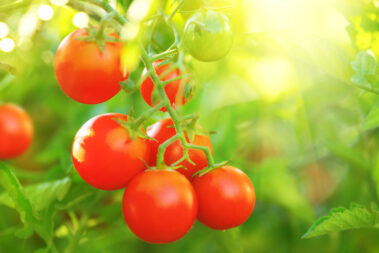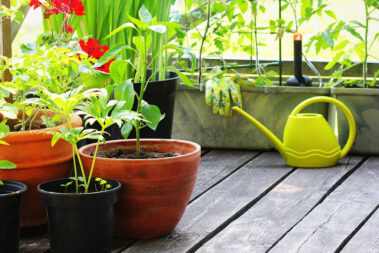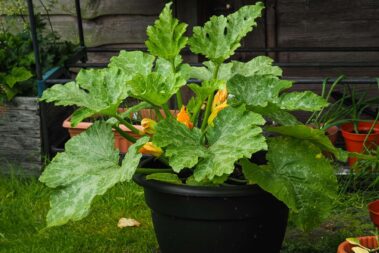With so many varieties available, from sweet to scalding, there’s a pepper out there for everyone.
But finding your favorite pepper often means bypassing the produce bins and growing your own. Luckily, even if you don’t have a yard or space in the garden, it’s still easy to grow peppers.
These compact nightshades actually do quite well in pots assuming you can meet a short list of requirements.
If you’re interested in growing peppers in order to find your new favorite but don’t have a garden, keep reading. We’ll give you nine tips for growing bountiful peppers in pots, tell you how to deal with common problems, and share our favorite recipes for cooking up home-grown peppers.
Table of Contents
Which Pepper Varieties Do Best In Pots?
Compared to tomatoes and eggplants, pepper plants are a relatively compact nightshade. But some types tend to grow better in the restricted space provided by containers than others.
Here are a few pepper varieties to consider when constructing your container garden.
- Bell Peppers – These sweet favorites are not as easy to grow in pots as some of their smaller pepper cousins, but it can be done. Look for varieties of red, orange, yellow, or purple that mature quickly and maintain a more compact form as they grow.
- Bulgarian Carrot Peppers – Don’t let the name fool you, these slender, orange peppers aren’t sweet like their namesake. In fact, they are pretty dang hot–almost three times hotter than the average jalapeño. They grow on bushy plants that produce dozens of fruit, making them a great option for containers.
- Bolivian Rainbow Peppers – Often grown as an ornamental plant due to their sheer beauty, these peppers are perfect for the container garden or for the front porch. This large plant produces a rainbow of hot peppers including yellow, orange, red, and purple.
- Fushimi Sweet Peppers – These thin, sweet peppers have a crunchier texture than the similar shishito and are delicious even when raw. They’re also one of the easiest peppers to grow in pots and produce beautiful fruit all summer long.
- Jalapeño Peppers – This popular hot pepper comes in many sub-varieties that do very well in pots. Look for types with a short growing season or shorter stature when picking a plant to include in your container garden.
- Poblano Peppers – Deep green and extra-large, these beautiful mild peppers are the preferred type for making chili Relleno. Despite their size, this variety is known to do quite well in large container pots.
- Shishito Peppers – These long green peppers are sweet with just a hint of spice. They are common in East Asian cooking and make a delicious snack when sauteed with oil and spices. They’re one of the easiest peppers to grow in general and do very well when grown in pots.
- Banana Peppers – These dull yellow, medium-sized peppers have a mild flavor with some added tang. They’re often stuffed and roasted, diced and added to dishes raw, or sliced and pickled for an excellent sandwich topper.
- California Wonder – This hugely popular green/red bell pepper makes a great container pepper plant thanks to sturdy stalks that resist leaning even as the hefty peppers begin to mature.
- Ghost Peppers – These infamously spicy peppers have shriveled red skin and are aptly shaped like a flame. Once known to be the hottest peppers in the world, ghost peppers often measure over a million on the Scoville scale.
- Gypsy Pepper – These sweet, three-lobed peppers make great snacking veggies and the perfect colorful addition to any salad. The short stalks of the gypsy perform well in pots and produce light green peppers that mature to orange and then red.
Why Grow Peppers?
All varieties of peppers have something to offer in terms of nutrition.
Colorful options, especially red and orange varieties, are loaded with vitamin C and other powerful antioxidants. But even green peppers are highly nutrient dense and have plenty of health benefits. Like many other vegetables, peppers of all colors are low in calories and high in fiber.
One health-supporting compound that’s unique to the pepper family is capsaicin. This compound is what makes spicy peppers burn when you eat them.
Health Benefits of Capsaicin
Capsaicin may offer pain-relieving properties. It may also help slightly boost metabolic rate, or how many calories you burn – which can provide a small boost if you’re trying to lose weight. Capsaicin may also help to increase muscle endurance, offering benefits for weight lifters.
Capsaicin stimulates pain receptors in your mouth. Interestingly, not all animals have these receptors. Birds are completely unaffected by capsaicin, which is why adding cayenne pepper powder to your bird feeders keeps squirrels away without affecting your feathered friends.
This potent compound is also effective against insects. It not only causes metabolic disruption when ingested but can rupture cells and cause nervous system damage when bugs come into contact with it. This means you can use dried flakes and oil from your spicy pepper harvest to protect your other vegetables from pest damage.
While deadly to bugs, studies show that capsaicin can be quite beneficial to humans. It may aid in weight loss and help reduce inflammation in the body (1,2). Topically, capsaicin has been shown to reduce pain associated with arthritis, neuropathy, and joint inflammation (3).
9 Tips for Growing Peppers in Pots
Once you’ve chosen your pepper varieties, it’s time to start planning and planting! Here are nine tips to ensure your pepper container garden is a success.
1. Pick a Hot Location
When picking a location for your pepper container garden, the most important aspect to consider is sunlight. All peppers need at least six hours of direct sunlight each day. But more is better.
Like all nightshades, peppers love the heat. They thrive in full sun and in daytime temperatures between 70 and 80 degrees. At night, they don’t like to get much cooler.
Putting your pots against a south-facing wall that gets a lot of sun will guarantee plenty of heat and light. It’ll also help keep the soil temperature high early in the year to produce faster growth.
2. Find the Right Pot
Some of the more compact pepper varieties will do fine in pots as narrow as 8 inches. But larger plants will do best in containers at least a foot in diameter. In either case, make sure your pot is at least 10 inches deep to allow for adequate root growth.
Five-gallon buckets are the perfect size for most peppers. If you plan to plant more than one pepper in each pot–something that’s possible with non-bushy varieties of bell peppers and others–pick a pot with a diameter wider than a foot.
Whatever pot you choose, make sure it has plenty of drainage holes. Peppers like moist soil but don’t do well in waterlogged pots. If needed, take a drill with a large bit to the bottom of your plastic or metal container to add extra drainage holes.
3. Pick Good Potting Soil
The soil inside pots is subject to a much different environment than the soil in a garden bed. There are no earthworms or other bugs available to aerate it. And it’s much more likely to dry out since it has a more limited volume and cannot pull water from lower depths.
For this reason, regular garden soil or dirt pulled from the ground will not work well for growing veggies in pots.
Instead, you need to purchase special potting soil that is made for the environment inside a container. This soil drains quickly while trapping moisture evenly from top to bottom. It’s also less prone to compaction than other types so roots can breathe easily and optimized to deliver the right pH for vegetable gardens.
One of our favorite products is this organic potting mix from Espoma. Mix your preferred potting soil with a little compost at a ratio of 4 to 1 and add it to your containers.
4. Select the Right Pepper Variety
In the section above, we looked at many pepper varieties that do well in containers. This list is a great place to start for those less familiar with container gardening. However, it’s possible to grow most types of peppers in containers.
For varieties not mentioned above and those not directly advertised for container planting, make sure you use an extra-large pot. This will ensure the plant’s roots have enough room to grow and will better emulate their natural growing environment.
5. Sow Early or Buy Seedlings
Most pepper varieties take some time to mature, and all prefer to produce during the hottest months of the year. This means that your window for growing peppers is fairly limited in most climates.
Direct sowing pepper seeds into your pots is generally only possible if you can bring your pots inside until the plants are large enough and the weather has warmed up. You also have the option to sow seeds in smaller containers and transplant them. You can sprout your seeds indoors using a seedling heat mat or in a greenhouse.
Transplant them into your outdoor pots once they have sprouted their third set of leaves and the last frost date has passed.

Buying seedlings and planting them in your containers after the weather has already warmed up is an easier route to take. But, keep in mind, you won’t be able to find the same variety of pepper plant seedlings as you can with pepper seeds.
6. Fertilize Twice a Month and Water Daily
Once the temperature warms up to the hot temps peppers like, you’ll most likely need to water your pots every day. Check the soil moisture level by sticking your finger into it. If the top inch or so is dry, then give the pot a healthy drink.
It’s best to water in the morning before it’s hot enough for rapid evaporation to occur. This will also guarantee your peppers don’t sit in soggy soil overnight. If you’re having to water very frequently, consider adding mulch or straw to the pot to reduce evaporation.
Because peppers produce fruit at such a fast rate, they require frequent fertilization. This is especially true of peppers in pots because a lot of the nutrients are washed away with each watering. By applying a balanced veggie fertilizer every two weeks, you’ll ensure your peppers get everything they need to keep producing.
7. Keep an Eye Out for Top-Heavy Growth
Peppers don’t require any trimming or special maintenance, but you do need to watch out for the plants becoming too top-heavy. This is most common in bell peppers and other large pepper varieties.
As the plant produces more and more fruit, the stem may start to bend. If this happens, use a tomato cage or bamboo stake to prop the plant up. Just be sure not to tie the plant too tightly.
8. Harvest When Ripe
Most pepper varieties can be harvested when the pepper first turns green or when it has matured into a more vibrant color.
For many spicy peppers, the less mature green fruit isn’t as hot as the more mature red or orange. Likewise, mild and sweet peppers tend to have more flavor after they have turned yellow, red, or purple. What color transitions your particular pepper goes through will depend on the variety.
9. Continue to Harvest All Summer Long
Most pepper types will produce as long as the weather is warm. By picking fruit early and often, you can encourage better production, especially early in the season.
If the weather gets too hot, the plant may drop its flower buds and production will decrease. But existing fruit should continue to ripen (and hot peppers will be much hotter!). To avoid this drop in pepper production, you should move your pots to a slightly cooler location during the hottest period of the summer.
If you have a sunny, south-facing window, you can bring your pepper plants inside once the weather cools to extend the season. Any plants left outside after a frost will die.
Common Problems You Might Face
In general, growing plants in pots means you don’t have to deal with as many pest problems as you do in a traditional garden. However, there are still a few problems to watch out for when growing peppers in containers.
- Pests – Aphids, corn borers, and whiteflies can sometimes cause issues for pepper plants. If you notice any bugs going after your pots, try moving them away from other plants and areas of open soil. Washing the leaves with warm soapy water can also help remove many types of foliage destroying bugs.
- Bacterial Leaf Spot – This is a common issue in pepper plants that causes round yellowish-black spots on the foliage. Using fresh soil each growing season and placing your pots away from other plants will help avoid this problem. If you do see a leaf with black spotting, cut it off and dispose of it right away to slow the spread.
- Blossom End Rot – This condition causes the blossom end of the pepper to turn mushy and brown before the fruit has matured. Blossom end rot is caused by an inadequate uptake of calcium. Frequent fertilization and, more importantly, a consistent watering schedule should prevent this issue in potted peppers.
- Flea Beetles – These small, shiny beetles feed on plant leaves, leaving behind pits and holes that can cause extensive damage to young plants. Infestations can be treated with neem oil, diatomaceous earth, or rubbing alcohol mixed with soapy water. Since only seedlings and young transplants are affected, covering your pots with row covers until your plants have reached maturity is also effective at preventing damage.
- Spider Mites – Leaves covered in brown, papery patches and overrun with webs are a sure sign of spider mites. If left unchecked, spider mites can decimate even healthy adult plants. Luckily, you can control these insects by dousing the leaves in soapy water a few times per week.
The Best Ways to Enjoy Your Crop
Now that you know how to grow your very own peppers, here are some of our favorite recipes to use them in.

- Cauliflower Rice Stuffed Peppers – This tasty recipe is perfect for large bell peppers of all colors.
- Slow Cooker Vegetarian Chili – Adding any type of pepper to this classic chili will only serve to increase the flavor profile. We especially like using anaheims, jalapeños, and serranos.
- High Protein Vegan Breakfast Burrito – This recipe calls for bell peppers but if you like a bit of a kick, try some jalapeños or fushimis instead.
- Spring Roll Bowl with Savory Peanut Sauce – This is another tasty recipe that calls for bell peppers but could easily be stepped up a notch with a spicier variety. Try fushimis or shishitos for a traditional Japanese kick.
- Vegan Grilled Cheese – This awesome grilled cheese recipe blends pimento peppers into the ooey-gooey “cheese” mixture for an added bite. If you don’t have pimento in your container garden, substitute any spicy-sweet variety.
- Roasted Red Peppers – If you love roasted peppers that come in a jar from the store, you’ll die for this fresh, home-roasted version.
- Pesto and Red Pepper Sandwich – Once you’ve made those delicious red peppers from the recipe above, put them to use by throwing together this amazing sandwich that includes decadent roasted onions and mushrooms, and flavorful pesto.
- Crispy Teriyaki Tofu Bowl – This colorful tofu and veggie bowl features raw bell pepper strips for a fresh, satisfying crunch.
- Vegan Pumpkin Chili – This amazing fall chili calls for bell peppers, but don’t be afraid to spice it up with some other sweet and spicy varieties.
- Marinated Veggie Kebabs – These curry-marinated kebabs are bursting with flavor. And utilizing fresh bell peppers or other peppers from your garden only adds to the experience.
Before you start prepping any of these recipes, make sure to check out our how-to guides on chopping bell peppers and freezing stuffed peppers.
- How to Pick the Perfect Watermelon For a Sweet Summer Treat - April 10, 2024
- Future Kind’s Foundations: A Multivitamin Made for Vegans - December 5, 2023
- Does Nutritional Yeast Go Bad? - November 28, 2023







